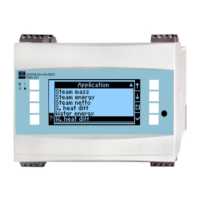Appendix RMS621
70 Endress+Hauser
How should the Energy Manager and the sensor be configured?
Accuracy of air flow measurement with an orifice plate depending on the measurement
method
Example:
• Orifice corner tap DP0 50: internal diameter 200 mm; ß = 0.7
• Flow operational range: 14.5 to 6785 m
3
/h (0 to 813.0 mbar)
• Sizing parameter: 10 bar; 200 °C (392 °F); 4.85 kg/m
3
; 4000 m
3
/h
• Process temperature: 190 °C (374 °F)
• Process pressure (true value): 11 bar (159.5 psi)
• Differential pressure: 270 mbar (3.92 psi))
a. Result when measuring based on the traditional differential pressure method:
Operating volume: 4000 m
3
/h Mass flow: 19.41 t/h (density: 4.85 kg/m
3
)
b. Result with improved, fully compensated differential pressure method (real flow):
Operating volume: 3750 m
3
/h Mass flow: 20.75 Nm
3
/h (density: 5.53 kg/m
3
)
The measured error for traditional flow measurement is approx. 6.5%.
Splitting Range (measuring range extension)
The measuring range of a differential pressure transmitter is between 1:3 and 1:7. This function
gives you the opportunity of extending the measuring range of the flow measurement to 1:20 and
more by using up to three differential pressure transmitters per flow measuring point.
Notes on the configuration:
1. Select Flow/Splitting Range 1 (2, 3)
2. Define the signal and select the differential pressure transmitter (applies to all differential
pressure transmitters!)
3. Select the terminals for the transmitters and define the measuring ranges.
Range 1: transmitter with the smallest measuring range
Range 2: transmitter with the next biggest measuring range etc.
4. Specify curve, units, format, sums, pipe data etc. (applies to all transmitters)
!
Note!
In the Splitting Range mode, it is compulsory to use differential pressure transmitters which output
currents > 20 mA (< 4.0 mA) when the measuring range is overshot. The system automatically
switches between the measuring ranges (hysteresis in switchover point).
Sensor type Unit
1. Traditional
method
No data available on the pipe diameter and diameter ratio ß (k-factor for Pitot tube).
a) (Default)
Square root curve e.g. 0...1000 m
3
(t)
Flow input (operating volume or mass)
Linear curve e.g. 0...1000 m
3
(t)
b) Linear curve e.g. 0...2500 mbar Flow input (operating volume or mass)
Curve square root, e.g. 0...1000 m
3
(t)
2. Improved
method
Pipe diameter and diameter ratio ß (k-factor for Pitot tube) known.
a) (Default) Linear curve e.g. 0...2500 mbar Special flow (DP) e.g. orifice plate
Linear curve e.g. 0...2500 mbar
b) Square root curve e.g. 0...1000 m
3
(t) Special flow (DP) e.g. orifice plate
Curve square law 0...2500 mbar

